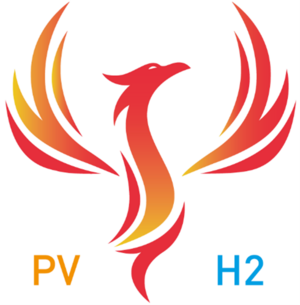A demonstration unit was constructed on AIT’s research campus in Seibersdorf: The “P2P H2-Demonstrator“. In PH2OeNIX, this H2-Demonstrator investigates the operating behaviour of different electrolysis technologies under a dynamic load profile, particularly given through the volatile power generation of photovoltaics.
In contrast to conventional concepts, where the electrolyser is connected to the electricity grid to increase its full-load hours, the PH2OeNIX H2-Demonstrator draws its electricity for hydrogen production solely from a PV system.
Project goals
PH2OeNIX explores the impact of direct coupling of PV systems and water electrolysis systems of different technologies. Key research questions include:
- Initial aging behaviour of modern PV module technologies
- Yield suitability of various PV system topologies for electrolysis applications
- Self-consumption rates under real operation
- Impact of direct system coupling on hydrogen production
- Overall efficiency and part-load capability
Technical details
The electricity from a roof-top PV system nearby with a nominal power of approx. 63 kWp feeds two electrolysers, each of approx. 10 kW electrical power. Two different electrolysis technologies are under investigation: The Proton Exchange Membrane (PEM) and the younger Anion Exchange Membrane (AEM) technology. The hydrogen produced during the day is stored in gas cylinders at the electrolyser output pressure, approx. 30 bar. During the night or late afternoon, a PEM fuel cell of 8 kW electrical power utilises the stored hydrogen to produce electricity, thus closing the power-to-H2-to-power (P2P) conversion circle.
Innovation and targeted results
To accelerate the market entry of innovative hydrogen applications, a key aspect of the evaluation of the PH2OeNIX H2-Demonstrator is translating the findings into replicable use-cases derived from the direct coupling of photovoltaics and electrolysis. The project involves assessing various PV-H2 application scenarios based on system combinations and monitoring. Application cases for industrial sites will be created and evaluated in terms of technical conditions and profitability thresholds. This will be followed by a technical analysis and conclusions on the sizing factors of PV systems, H2 production, storage, and reconversion units, focusing on self-consumption rates, coverage ratios, and storage requirements (such as peak load shaving and load shifting).






